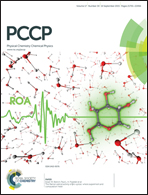Hydrogen-bonded ring closing and opening of protonated methanol clusters H+(CH3OH)n (n = 4–8) with the inert gas tagging†
Abstract
The preferential hydrogen bond (H-bond) structures of protonated methanol clusters, H+(MeOH)n, in the size range of n = 4–8, were studied by size-selective infrared (IR) spectroscopy in conjunction with density functional theory calculations. The IR spectra of bare clusters were compared with those with the inert gas tagging by Ar, Ne, and N2, and remarkable changes in the isomer distribution with the tagging were found for clusters with n ≥ 5. The temperature dependence of the isomer distribution of the clusters was calculated by the quantum harmonic superposition approach. The observed spectral changes with the tagging were well interpreted by the fall of the cluster temperature with the tagging, which causes the transfer of the isomer distribution from the open and flexible H-bond network types to the closed and rigid ones. Anomalous isomer distribution with the tagging, which has been recently found for protonated water clusters, was also found for H+(MeOH)5. The origin of the anomaly was examined by the experiments on its carrier gas dependence.


 Please wait while we load your content...
Please wait while we load your content...